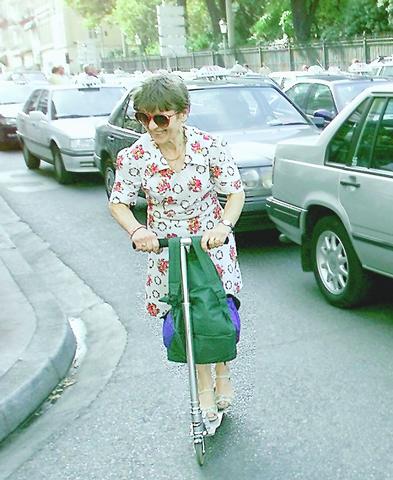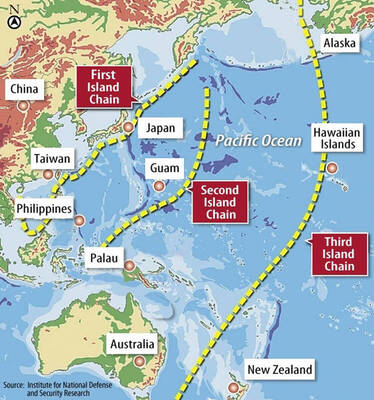By his own admission, J.D. Corp President Gino Tsai doesn't like walking. "My legs are too short, and my walking speed always seems too slow," he says.
Tsai wanted a better way to get around the factory floor, something smaller and more compact than a bike, and easier than walking. He put the company's research and development team to work, and before long they had invented the hottest new product of the year, the Razor Scooters that are suddenly so popular on the streets of New York, Tokyo and Europe.
But the two-year journey from conception to hit product is not a story of savvy marketing and clever promotion. Quite the opposite -- the Razor Scooter proved so popular that customers clamored for it, and J.D. Corp's key concern was to ramp up production fast enough to meet the unexpected demand.

PHOTO: AFP
Basically, Tsai built a better mousetrap, and the world beat a path to his door.
It took five years to develop the current model. The first version had a steel base and 25cm rubber wheels, but at 6kg it was too heavy to carry around. Tsai added electric power to the second version, but it was still heavy, and had the added inconvenience of a battery that had to be charged.
It was the third generation scooter that proved to be the winner. By adding polyurethane wheels and making the base from aircraft-grade aluminum, J.D. Corp produced a compact, easy-to-carry prototype that weighed just 3kg. Never again would Tsai have to walk around the factory floor.
The Razor Scooter's commercial launch came almost by accident. Tsai took the prototype to the NSGA World Sports Expo, held July 17 to 19, 1998 in Chicago, where J.D. Corp was marketing its line of aluminum bicycle parts. As Tsai scooted around the show, he attracted the attention of Sharper Image Corp. Tsai asserts that though his scooter was only a prototype, not a show product, Sharper Image was very interested.
The US retailer placed the first order for the Razor: 4,000 scooters. But it was the Japanese market that gave the Razor its rocket-like launch. In January 1999, J.D. Corp showcased the scooter for the first time, at the Hong Kong Toys and Games Fair. There it caught the attention of Atras Auto Co Ltd, a Japan-based importer of European cars. In April 1999, Atras placed an order for 300 Razor scooters.
Atras knew its market well. Rather than advertise the Razor as a sporting good, Atras promoted it as a fashion accessory, a must-have item for the ultra-hip of Tokyo. That caught the eye of the fashion-conscious consumers, and soon the scooter had attracted the attention of the media as well. By August 1999, Japanese customers were demanding more Razors than J.D. Corp could produce.
In the US meanwhile, the Razor had become a popular toy among daredevil teenagers, and a user group called Razor Team had sprung up in Los Angeles. Tsai admits he doesn't understand the US market, so the company asked Razor Team to be its American agent. In May, Razor Team accepted and formed a company called Razor USA. The Razor's adoption and promotion by trend-setting generation-X Californians helped cement its image as a hip, youthful product.
In its 15 years of existence, J.D. Corp has never had a hit like the Razor. Until recently, it had produced a line of aluminum bicycle parts, along with its own Tranz X bicycle brand and City Bug electric scooters. But sales were middling, and J.D. Corp had always been just another little-known parts producer from Changhua.
Its biggest challenge was ramping up scooter production to keep up with demand, otherwise product awareness would fade and the trend would fizzle. Tsai moved quickly to expand his factory in Shenzhen. The company boosted output from just 500 scooters in May 1999, to 500,000 in June.
Of the half million Razors produced each month, about 150,000 go to the US, 150,000 to Japan, and 125,000 to Europe, with Hong Kong, Australia and other countries accounting for the rest.
"We were able to increase our volume in a very short time, and satisfy the demand very quickly, so we could catch up with the market," Tsai says.
In 1999, just 10 percent of the company's revenue came from the Razor, but this year the figure is expected to approach 90 percent. The company's 1999 revenue of US$40 million will more than double this year, Tsai claims, but beyond that he is not making any predictions.
Now that it has a hit, the company is trying hard to sustain the trend. It plans to introduce three separate models next year: a shorter, stronger Razor Sport for teens; a longer Razor Cruiser with comfortable suspension for leisure riders; and a more compact battery-operated Razor Power for urban transportation.
The streets of Taipei are full of kick-scooters, but you will very seldom see a genuine Razor. Local manufacturers, quick to copy a hit, have flooded the market with cheap imitations. But Tsai says he's not worried. Razor has applied for three US patents, and one has been granted already, and it has applied for another eight patents in Taiwan and China.
Taiwanese and Chinese manufacturers are not known for their respect for patent law, but Tsai believes Razor's customers will remain brand loyal.
"Our distributors tell us that their consumers ask for Razor Scooters only, and so the copies do not sell very well," he says. "Instead our customers increase their Razor Scooter orders."
How long will the trend last? Gary Melyan, a Taipei-based producer and exporter of sporting goods, says it might last as long as the roller blade and the updated skateboard -- or it might not. "It depends on what happens next summer," he says. "It will probably have a two-year lifespan, and after that it's hard to predict."
According to Melyan, prices and quality will fall as cheap producers enter the market. The Razor, with its comparatively high quality, has a reasonable chance of surviving past a second season.
High-quality producers survived the roller-blade shakeout as well, and if kick-scooters do survive, the Razor has a better chance than most of its competitors.
Tsai himself can't explain the sudden success of the Razor. "Even we don't understand why it is so hot right now -- we are very surprised," he says.
But one thing is certain he'll never have to walk around the factory floor again.

The US government has signed defense cooperation agreements with Japan and the Philippines to boost the deterrence capabilities of countries in the first island chain, a report by the National Security Bureau (NSB) showed. The main countries on the first island chain include the two nations and Taiwan. The bureau is to present the report at a meeting of the legislature’s Foreign Affairs and National Defense Committee tomorrow. The US military has deployed Typhon missile systems to Japan’s Yamaguchi Prefecture and Zambales province in the Philippines during their joint military exercises. It has also installed NMESIS anti-ship systems in Japan’s Okinawa

‘WIN-WIN’: The Philippines, and central and eastern European countries are important potential drone cooperation partners, Minister of Foreign Affairs Lin Chia-lung said Minister of Foreign Affairs Lin Chia-lung (林佳龍) in an interview published yesterday confirmed that there are joint ventures between Taiwan and Poland in the drone industry. Lin made the remark in an exclusive interview with the Chinese-language Liberty Times (the Taipei Times’ sister paper). The government-backed Taiwan Excellence Drone International Business Opportunities Alliance and the Polish Chamber of Unmanned Systems on Wednesday last week signed a memorandum of understanding in Poland to develop a “non-China” supply chain for drones and work together on key technologies. Asked if Taiwan prioritized Poland among central and eastern European countries in drone collaboration, Lin

Renewed border fighting between Thailand and Cambodia showed no signs of abating yesterday, leaving hundreds of thousands of displaced people in both countries living in strained conditions as more flooded into temporary shelters. Reporters on the Thai side of the border heard sounds of outgoing, indirect fire yesterday. About 400,000 people have been evacuated from affected areas in Thailand and about 700 schools closed while fighting was ongoing in four border provinces, said Thai Rear Admiral Surasant Kongsiri, a spokesman for the military. Cambodia evacuated more than 127,000 villagers and closed hundreds of schools, the Thai Ministry of Defense said. Thailand’s military announced that

CABINET APPROVAL: People seeking assisted reproduction must be assessed to determine whether they would be adequate parents, the planned changes say Proposed amendments to the Assisted Reproduction Act (人工生殖法) advanced yesterday by the Executive Yuan would grant married lesbian couples and single women access to legal assisted reproductive services. The proposed revisions are “based on the fundamental principle of respecting women’s reproductive autonomy,” Cabinet spokesperson Michelle Lee (李慧芝) quoted Vice Premier Cheng Li-chiun (鄭麗君), who presided over a Cabinet meeting earlier yesterday, as saying at the briefing. The draft amendment would be submitted to the legislature for review. The Ministry of Health and Welfare, which proposed the amendments, said that experts on children’s rights, gender equality, law and medicine attended cross-disciplinary meetings, adding that